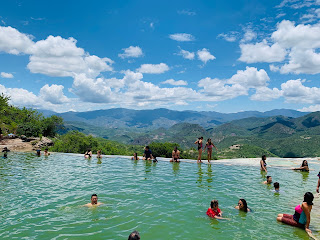As a captal, Oaxaca is the main hub for taking tours around the entire state. One of the tours we took was to Hierve el Agua and Mitla.
Hierve el agua (Water that Boils) is located about 60 km (37 miles) east of the Oaxaca. Par of the way there is through a brand new toll highway and part is through a very winding unpaved narrow road. It is frightening to see vehicles driving through such unpaved road because on the way to Hierve el agua, the passenger side sees a cliff (about 30 meters-98 feet) down. and on the way back the passenger side sees that.
Once in Hierve el agua though, it is a beautiful sight. With thermal waters springing from the mountain and creating natural pools for people to swim while enjoying the natural beauty of the entire mountains and valley.
After Hierve el agua, we headed to MITLA, the land of the underworld, dedicated to the God Mitlantecutli and the most important place for the Zapotec people.
Mitla is small but its importance to the Indigenous people of Oaxaca, specially during Day of the Dead, is indescribable.
During our visits to both Hierve el agua and Mitla, we stopped in three other places. A place where Indigenous people hand make zarapes and many other artifacts made of wool, a mezcal distillery, and a town with the longest living tree.
This image aboves hows the place where people dye the wool with all natural resources. It was amazing to see how they use natural material from the area to create such beautiful colors.
The image above shows a grinder where the already cooked and marinated maguey is thrown so the giant rock, pulled by a donkey, can grind the cooked mezcal in order to extract the juice, which will be treated, fermented, and left in barrels for different periods of time to create the different elixirs of the Gods: Mezcal.
The image above is from the town of TULE and the tree you see in the background is the longest living tree, with more than 2000 years in existence. Information available on the site states that the trunk is about 42 meters (137 ft) in diameter or circumference and 35 meters (116 ft) high.
Although not visible in this image, the trunk shows images of animals such as jaguars and elephants, horses, and more... for this reason, El árbol de Tule (The Tree of Tule) is also known as El árbol de la vida (The Tree of Life), which is the inspiration for the many variations of the "tree of life sculptures."
An example of a tree of life sculpture.
NEXT: CALENDAS!








No comments:
Post a Comment